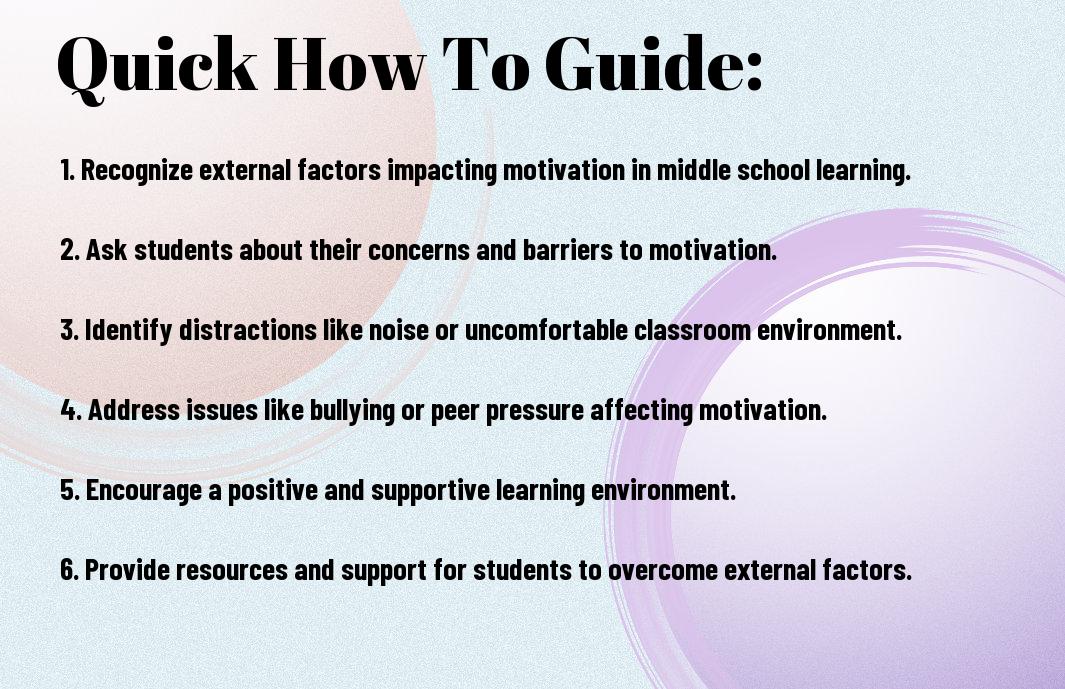How to Identify and Overcome External Factors Impacting Motivation in Middle School Learning

Have you ever found yourself struggling to stay motivated in your middle school studies? It’s important to recognize that external factors can play a significant role in your level of motivation and academic performance. In order to excel in your learning journey, it’s crucial to identify and overcome these external factors that may be impacting your motivation.
External factors such as peer pressure, family dynamics, and environmental stressors can all influence your ability to stay motivated and focused on your studies. By understanding and addressing these factors, you can take control of your own motivation and create a more positive and productive learning environment. In this blog post, we’ll explore various strategies and techniques to help you identify and overcome these external factors, ultimately empowering you to achieve your full potential in middle school. Stay tuned for actionable tips and advice to help you navigate and conquer the challenges that may be hindering your motivation.
Key Takeaways:
- External factors such as family issues, peer pressure, and social media can significantly impact middle school students’ motivation to learn. It is important to recognize and address these factors in order to support student learning.
- Teachers and parents should communicate regularly to identify potential external factors that may be affecting a student’s motivation. Creating a strong support network can help address these issues more effectively.
- Implementing strategies such as goal-setting and positive reinforcement can help motivate middle school students and counteract external factors that may be impacting their learning.
- It is crucial to encourage a positive and nurturing environment both at home and in the classroom to counteract the negative effects of external factors on motivation.
- Building resilience and teaching students to persevere in the face of external challenges is essential to help them overcome and combat external factors impacting their motivation in middle school learning.

Identifying Key External Factors
Clearly, there are a multitude of external factors that can impact your motivation in middle school learning. It’s important to recognize and address these factors in order to overcome any obstacles that may be hindering your academic success. After identifying the key external factors, you can devise strategies to navigate through them and stay motivated in your learning journey.
Analyzing Home Environment Influences
Your home environment can play a significant role in shaping your motivation and attitude towards school. Factors such as family dynamics, parental expectations, and the availability of a conducive study space can all impact your academic performance. Additionally, the level of support and encouragement you receive at home can greatly influence your motivation to excel in your studies. Understanding these influences can help you address any barriers and create a more supportive home environment for your learning.
Assessing the Impact of Peer Relationships
Peer relationships can have a significant impact on your motivation and engagement in school. Your friends and classmates can either inspire and support you or deter you from reaching your full potential. It’s important to assess the influence of peer relationships on your academic performance and identify any negative influences that may be affecting your motivation. By surrounding yourself with positive and supportive individuals, you can enhance your motivation and success in school.
The Role of School Climate and Culture
The school environment plays a crucial role in shaping your motivation and emotional well-being. The overall climate and culture of the school, including the level of support from teachers, the presence of bullying, and the availability of extracurricular activities, can all impact your academic engagement. Recognizing the influence of the school environment on your motivation can help you navigate any challenges and actively seek out resources to enhance your learning experience.
Media and Technology as External Stimuli
Media and technology can serve as both positive and negative external stimuli that may impact your motivation in middle school learning. The excessive use of social media, video games, and other digital distractions can hinder your academic performance and motivation. On the other hand, technology can also be used as a tool for learning and education. It’s important to recognize the influence of media and technology on your motivation and develop strategies to manage their impact on your academic engagement.
Societal and Cultural Expectations
Societal and cultural expectations can significantly influence your motivation and attitude towards learning. The pressure to conform to certain standards and expectations can create barriers to your academic success. It’s important to recognize the influence of societal and cultural expectations on your motivation and take proactive steps to develop a positive mindset and outlook towards learning. By understanding and addressing these external factors, you can cultivate a sense of autonomy and direction in your educational journey.
How-To Guide: Tools and Strategies for Teachers
Unlike internal factors that may impact a student’s motivation, external factors are often beyond their control. As a middle school educator, it is crucial for you to identify these external factors and implement strategies to help students overcome them. Here are some tools and strategies to help you support and motivate your students in their learning journey.
Developing a Supportive Classroom Environment
Creating a supportive classroom environment is essential for fostering motivation in middle school students. As a teacher, you can accomplish this by building strong relationships with your students, getting to know them on a personal level, and showing a genuine interest in their well-being. Additionally, creating a safe and inclusive space where every student feels valued and respected can go a long way in boosting their motivation to learn.
Tips for Enhancing Student Engagement
Enhancing student engagement is key to maintaining their motivation in the classroom. To achieve this, you can incorporate a variety of teaching strategies such as hands-on activities, group discussions, and interactive learning experiences. Additionally, integrating technology into your lessons can help capture students’ interest and keep them actively involved in the learning process. This can include using educational apps, online resources, or interactive presentations to make the learning experience more dynamic and interactive. This active engagement can significantly improve their motivation levels and overall performance. This is crucial for a positive learning experience, and it can make a big impact on their motivation to learn.
Individualized Learning Plans and Their Benefits
Individualized learning plans can help address the diverse needs of middle school students and support their individual learning styles. By tailoring lessons and assignments to their specific strengths, weaknesses, and interests, you can improve their motivation and performance. This approach acknowledges that every student has unique abilities and challenges, and providing personalized support can make a significant difference in their motivation and success.
Ensuring Consistent Communication with Parents
Consistent communication with parents is vital for supporting students’ motivation in their learning journey. By keeping parents informed about their child’s progress, behavior, and any challenges they may be facing, you can enlist their support in motivating their children at home. Additionally, involving parents in school activities and decision-making processes can create a collaborative support system for the students, further bolstering their motivation and success.
Fostering Peer Support and Collaboration
Fostering peer support and collaboration can significantly impact students’ motivation in middle school. Encouraging teamwork, group projects, and peer tutoring can create a sense of community and cooperation among students. This can boost their confidence, enhance their social skills, and provide a supportive network for them to rely on. Furthermore, peer support can help alleviate feelings of isolation and anxiety, which can hinder a student’s motivation. Cultivating a positive and collaborative classroom environment can foster a sense of belonging and motivation among your students.

How-To Guide: Involving Parents and Guardians
For middle school students, involving parents and guardians in their learning journey can have a significant impact on their motivation and academic success. By working together, you can create a supportive and enriching environment that encourages and nurtures your child’s love for learning. Here are some effective strategies to involve parents and guardians in supporting and enhancing your child’s motivation in middle school.
Effective Parent-Teacher Partnerships
One of the most powerful ways to support your middle schooler’s motivation is by establishing a strong partnership with their teachers. When you and your child’s teachers are on the same page and communicate regularly, it can create a unified front that reinforces your child’s learning experience. This can be achieved through attending parent-teacher conferences, actively participating in school events, and maintaining open lines of communication through email or phone calls. By working together, you can ensure that your child’s educational needs are addressed, leading to a more motivated and engaged learner.
Strategies for Home Reinforcement of Motivation
At home, you can reinforce and boost your child’s motivation by creating a conducive environment for learning. This can include establishing a dedicated study space, setting a consistent routine for homework and study time, and providing the necessary resources, such as books and educational materials. Additionally, you can encourage and celebrate your child’s achievements, which can significantly boost their confidence and motivation. By creating a supportive and nurturing home environment, you empower your child to approach their studies with a positive and motivated mindset.
Managing Screen Time and Digital Distractions
In today’s digital age, managing screen time and digital distractions is crucial for maintaining your child’s motivation in their studies. Excessive screen time and unfettered access to digital devices can lead to distractions and a lack of focus, impeding your child’s ability to stay motivated. By setting clear boundaries and limits on screen time, you can help your child develop self-discipline and focus on their academic responsibilities. Encourage alternative activities, such as reading, physical exercise, or creative hobbies, to provide a healthy balance and mitigate the negative impact of excessive screen time on your child’s motivation and overall well-being.
How-To Guide: Student-Centered Approaches
To create a student-centered approach in middle school learning, you need to focus on cultivating a growth mindset among students, encouraging student autonomy and choice, and implementing recognition and rewards for positive reinforcement. By employing these strategies, you can empower students to take ownership of their learning and boost their motivation.
Cultivating a Growth Mindset Among Students
One of the most effective ways to foster a growth mindset among middle school students is to emphasize the power of yet. Encourage them to understand that they may not have mastered a concept or skill yet, but with effort and perseverance, they can improve and grow.
Additionally, praise effort and progress rather than focusing solely on achievements. By reinforcing the idea that hard work and dedication lead to success, students are more likely to embrace challenges and view mistakes as opportunities for learning.
Encouraging Student Autonomy and Choice
Empowering students to make choices in their learning process can have a significant impact on their motivation. Providing options for how they demonstrate their understanding of a concept or allowing them to select topics for projects can increase their engagement and enthusiasm for learning.
Encourage students to set personal goals and take ownership of their learning journey. By doing so, they will develop a sense of responsibility and become more invested in their educational experience.
Recognition and Rewards: Tips for Positive Reinforcement
Implementing a system of positive reinforcement through recognition and rewards can further enhance motivation in middle school learning. Acknowledge and celebrate both individual and group achievements, and consider implementing a reward system that recognizes students’ efforts and accomplishments.
- Provide verbal praise and encouragement to acknowledge students’ progress and efforts.
- Consider using a rewards system, such as a point-based system with incentives for reaching certain milestones or demonstrating consistent effort.
- Offer tangible rewards, such as certificates, tokens, or small prizes, to reinforce positive behavior and academic achievement.
After implementing these strategies, you will notice a positive shift in the classroom culture as students become more motivated and engaged in their learning.
Overcoming Specific Challenges
Despite the external factors impacting motivation in middle school learning, it is important to address and overcome specific challenges to ensure that students remain motivated and engaged in their academic journey. It is important to recognize and understand the diverse needs of students, tackle academic pressure and stress, confront bullying and social anxieties, and ensure that resources and supports are available for students with learning disabilities.
Addressing the Diverse Needs of Students
When it comes to addressing the diverse needs of students in a middle school setting, it is essential to create an inclusive and supportive learning environment. This means acknowledging and respecting the individual differences and abilities of each student. By adapting teaching methods, providing personalized support, and promoting a sense of belonging, you can help students feel valued and motivated to actively engage in their learning.
Tackling Academic Pressure and Stress
Academic pressure and stress can significantly impact a middle school student’s motivation. It is essential to create a balanced approach to learning and academics, ensuring that students do not feel overwhelmed or overburdened by their studies. Encourage time management and stress-relief techniques, and remind students that it is okay to ask for help. By creating a supportive and understanding environment, you can help students manage their academic pressures effectively.
Confronting Bullying and Social Anxieties
Bullying and social anxieties are serious challenges that can greatly impact a student’s motivation and overall well-being. It is crucial to address and confront these issues head-on by fostering a culture of respect, empathy, and open communication. Encourage students to speak up, seek help from trusted adults, and promote kindness and inclusivity within the school community to combat bullying and social anxieties.
Resources and Supports for Students with Learning Disabilities
For students with learning disabilities, having access to appropriate resources and supports is crucial for maintaining motivation and achieving academic success. Ensure that individualized education plans (IEPs) are implemented effectively, offer additional support through special education programs, and provide assistive technologies to help students overcome their learning challenges. By acknowledging and catering to the specific needs of these students, you can help them thrive in their academic journey.
Sure, here is the content for the chapter on Measurement and Adjustment:
Measurement and Adjustment
Now that you have identified the external factors impacting motivation in middle school learning, it’s important to measure the impact and make necessary adjustments to address any negative influences. Measurement and adjustment is crucial to maintaining a positive and motivating learning environment for your students.
Monitoring Student Progress and Motivation
Monitoring your students’ progress and motivation levels is essential to understanding how external factors are impacting their learning experience. Regularly assess their engagement, participation, and overall performance. Keep an eye on any changes in behavior or attitude towards learning, as these can be indicators of external factors affecting their motivation.
How-To Utilize Feedback for Continuous Improvement
Feedback from students, parents, and other educators can provide valuable insights into the external factors that are impacting motivation in middle school learning. Actively seek feedback and use it to continuously improve your teaching methods and the learning environment. Adjust your strategies based on the feedback received to address any external factors negatively impacting motivation.
Adapting Strategies to Ever-Changing External Factors
Adapting your teaching strategies to address ever-changing external factors is crucial in maintaining a positive and motivating learning environment. Some strategies include flexible lesson planning, incorporating diverse teaching methods, and creating a supportive classroom culture. Emphasize the importance of resilience and adaptability in the face of adversity. Adapt your teaching approach to accommodate different learning styles and individual needs. Remember, the educational landscape is constantly evolving, and so should your approach to teaching.
- Flexible lesson planning
- Incorporating diverse teaching methods
- Creating a supportive classroom culture
Though external factors may continue to evolve, your ability to adapt and address them will ensure a positive and motivating learning experience for your middle school students.
Conclusion
Following this guide, you should now have a better understanding of the external factors that can impact motivation in middle school learning. You have learned how to identify these factors, such as home environment, peer influence, and school culture, and have gained insight into how they can affect your motivation to learn. By recognizing these external influences, you can take proactive steps to overcome them and maintain your motivation in your academic pursuits.
Remember that you have the power to control your response to external factors and to adopt strategies that will help you stay motivated. Whether it’s creating a positive study environment at home, surrounding yourself with supportive friends, or seeking out additional resources and support at school, there are various ways to mitigate the impact of external factors on your motivation to learn. With perseverance and the right mindset, you can overcome these challenges and continue to thrive in your middle school education.
FAQ
Q: What are external factors that impact motivation in middle school learning?
A: External factors that can impact motivation in middle school learning include peer pressure, family dynamics, socioeconomic status, and the school environment.
Q: How can we identify external factors impacting motivation in middle school learning?
A: To identify external factors impacting motivation in middle school learning, it is important to observe changes in behavior, academic performance, and interaction with peers. Conducting surveys or interviews with students and their parents can also provide valuable insights.
Q: What are some strategies to overcome external factors impacting motivation in middle school learning?
A: Strategies to overcome external factors impacting motivation in middle school learning include creating a supportive and inclusive school environment, providing counseling and mentorship programs, offering extracurricular activities, and promoting a growth mindset in students. Additionally, involving parents and guardians in the educational process can help address external factors and provide necessary support for students.